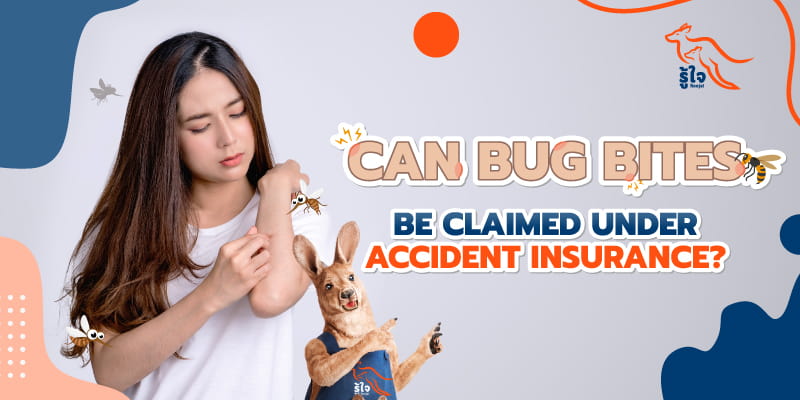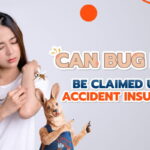
Thailand’s warm, tropical climate makes it a paradise for travellers and expats, but also for mosquitos, ants, and all kinds of insects. Bug bites and animal encounters might not seem like major accidents, but depending on the injury, they could be covered by personal accident insurance.
So, what happens if you get bitten or stung and need medical treatment? Can you make a claim on your personal accident insurance? The answer is yes, under certain conditions. Here’s what you need to know.
Understanding personal accident insurance
Personal accident insurance is designed to offer financial protection in case of injuries resulting from unexpected accidents. Most policies cover events such as broken bones, burns, or loss of limbs, provided these resulted from sudden and external causes. These typically include:
- Falls or collisions resulting in broken bones or cuts
- Accidents at work or at home
- Accidental falls or collisions
- Burns or injuries from unexpected incidents
But what if the injury is caused by an insect or animal bite? The answer depends on how the event and resulting injuries are classified. For an incident to qualify as an accident under your policy, it must generally meet the following criteria:
- It must be sudden
- It must be unforeseen
- It must cause physical injury from an external source
- It must require medical treatment

When might bug bites be covered?
A bug or animal bite can be covered under personal accident insurance if there is a visible injury and a doctor determines that medical treatment is necessary. For example:
- The injury must be visible and diagnosable (e.g. a bite mark, bleeding, swelling, or a stinger lodged in the skin).
- The injury must require hospital care and this must be documented by a doctor.
- The incident must be classified as an accident, not a pre-existing condition or illness.
These cases involve identifiable wounds and medical intervention, meeting the criteria for an accident claim. However, claims are not covered when the bite or sting only causes mild symptoms like itching, redness, or a rash, particularly when no wound is visible and no medical treatment is needed.
Interestingly, even incidents like dust in the eye or a fishbone stuck in the throat may qualify, as long as a doctor diagnoses an actual injury (e.g., a scratched cornea or a wound in the throat). What matters most is that the incident is sudden, accidental, and results in injury requiring medical care.
Important: Timing matters
The time in which you file your claim is just as important as the process itself. Many personal accident policies, like ours, require that you seek medical attention within 24 hours of the incident. Always review your policy terms to ensure you meet claim conditions.
What’s not covered by personal accident insurance
While the coverage is broad, there are situations where personal accident insurance won’t apply. These exclusions include:
- Being under the influence of alcohol or drugs at the time of the accident.
- Intentional self-harm or suicide.
- Miscarriage or pregnancy complications.
- Participation in war, riots, or civil unrest.
- Joining protests or organized work stoppages (unless injured unintentionally as a bystander).
- Exposure to radiation or nuclear activity.
- High-risk or extreme sports (e.g., skydiving, boxing, racing) unless coverage has been extended.
- Driving or riding a motorcycle without additional coverage.
- Flying in non-commercial aircraft like helicopters or military planes.
- Committing crimes, fighting, or fleeing law enforcement.
- Performing official duties as a soldier, firefighter, police officer, or rescue volunteer during working hours.
Always check your policy carefully to understand what’s excluded, and whether you can add optional coverage for high-risk activities like extreme sports or frequent motorcycle use.
Documents needed to file a claim for a bug bite
If you’ve been bitten or stung and believe you’re eligible for a claim, follow these steps when seeking treatment:
- Inform hospital staff right away that you’ll be filing an insurance claim.
- Request the following documents:
- A completed claim form (from Roojai or the hospital).
- A medical certificate stating the diagnosis, symptoms, and treatment.
- A copy of your national ID with a certified signature.
- Original itemized receipts for all expenses.
- Any additional documentation requested by Roojai, depending on the case.
Be sure to submit your claim promptly, ideally as soon as possible after receiving treatment.
What to check in your policy
Your personal accident insurance policy outlines exactly what’s covered and under what conditions. Pay attention to:
- The definition of “accident”
- Exclusions related to illness or minor symptoms
- Required timeframes for treatment and claim submission
- Documentation requirements for a successful claim
If you’re ever unsure, our team is here to help clarify your coverage.
Conclusion
Bug bites and other minor injuries may seem trivial, but if they result in visible wounds and require medical attention, they can be covered under personal accident insurance. The key is timely treatment and proper documentation.
If you’re currently considering personal accident insurance, remember that not all policies are created equal. While many insurers offer similar basic plans, the best plan for you is one that fits your lifestyle. Roojai offers personal accident insurance that you can customise your coverage, so you only pay for what you actually need. You can add options for extreme sports or motorcycle coverage to make sure you’re fully protected, all under one affordable and comprehensive policy.
Stay informed with helpful tips on health, cars, motorcycles, and all things insurance by following us on Facebook or adding us on LINE.



